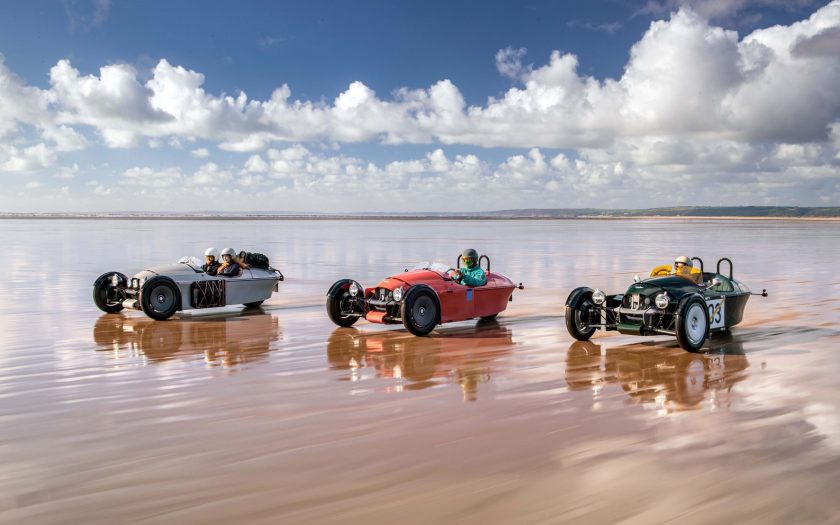SOME OF US MAY RECALL that the original Morgans from that quirky UK company appeared to be one short of what many would consider the ideal number of wheels for a car.
Now, in what could be seen as a return to its roots, the company has unveiled a new three-wheeler, the Super 3. It has been designed from the ground up to offer new levels of character, thrill and adventure, principles that have defined Morgan’s three-wheeled product since the company was founded 113 years ago.
At the very heart of Super 3’s personality is its driving character. Primarily, a three-wheeled Morgan is a vehicle that entices you to get behind the wheel, offering a unique combination of mechanical feel, connection to the environment and visual differentiation from anything else on the road. Few vehicles will engage their occupants like Super 3.
As the company’s most configurable model to date, Super 3 offers an extensive list of options and accessories that allow owners to tailor their own experience. From adventure touring accessories to race-inspired liveries, Super 3 adopts multiple personalities to reflect the individuality of its owner. Three expressions of these personalities can be seen on the launch vehicles.
Like every Morgan, Super 3 will be built in Malvern, Worcestershire, at the company’s Pickersleigh Road factory. Skilled craftsmen and women have been handcrafting cars in these hallowed red brick buildings since 1914, just five years after HFS Morgan invented the first Morgan, known as ‘The Runabout’.
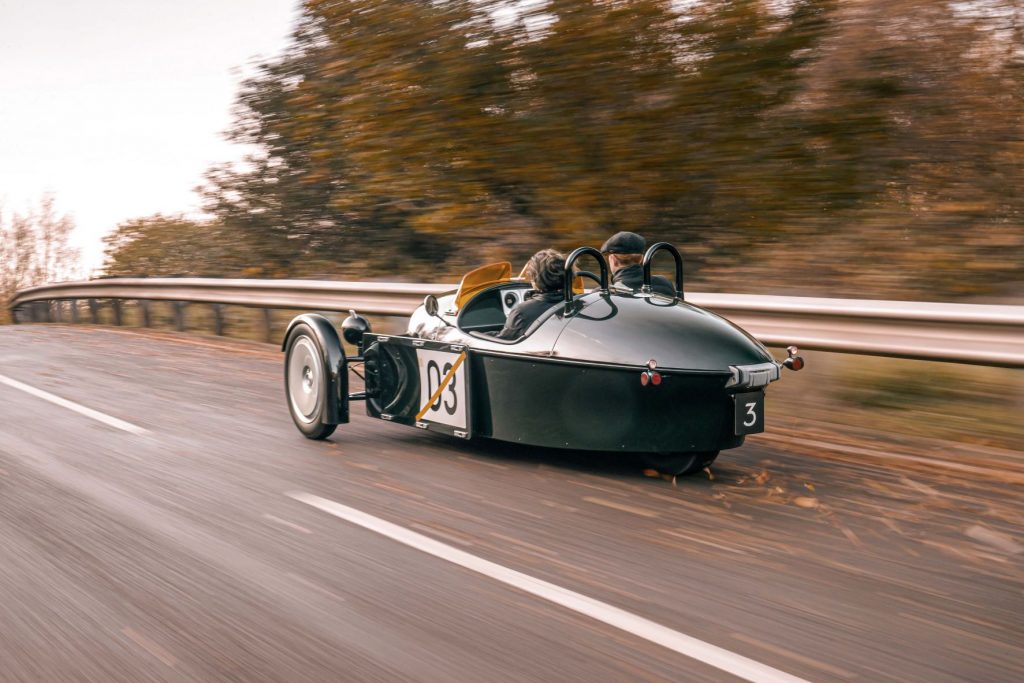
Design
With Super 3, Morgan introduces a new design philosophy. In comparison with the outgoing 3 Wheeler, which was created in the style of the 1920s V-twin-engined three-wheelers, Super 3’s designers and engineers have drawn influences from the mid to late century.
Aerodynamic and mechanical requirements have heavily influenced the form and proportions of Super 3. This is most notable in the cast aluminium structures that provide the face of the vehicle, brace the engine and control the corner packages, while also directing air into the side-mounted cooling packs.
Two rectangular ‘diffuser plates’ – referred to as ‘sideblades’ – intelligently manage cooling requirements while also presenting a platform for panniers, luggage racks and liveries.
Super 3 is Morgan’s first clean-sheet design since the launch of the Aero 8 in 2000 and the company’s biggest visual departure since the 1962 Plus 4 Plus. Super 3 challenges the typical perceptions of Morgan design yet remains true to the company’s underlying principles and heritage.
The exact positioning of the engine – now car-derived and mounted in-board – within Super 3 is of crucial importance. The compact inline three-cylinder block sits precisely behind the front axle line, delivering optimum weight distribution.
Honesty of design is one of Morgan’s key principles, and Super 3 embodies this wherever you look. Every feature – no matter how superficial it may appear – has an underlying mechanical purpose: the vehicle celebrates the marriage of design and engineering. Examples of this are prominent throughout Super 3. Features such as the metallic impressions in the footwell side panels, which stiffen the surface but are exposed as a design feature. Everything is honest, with reason.
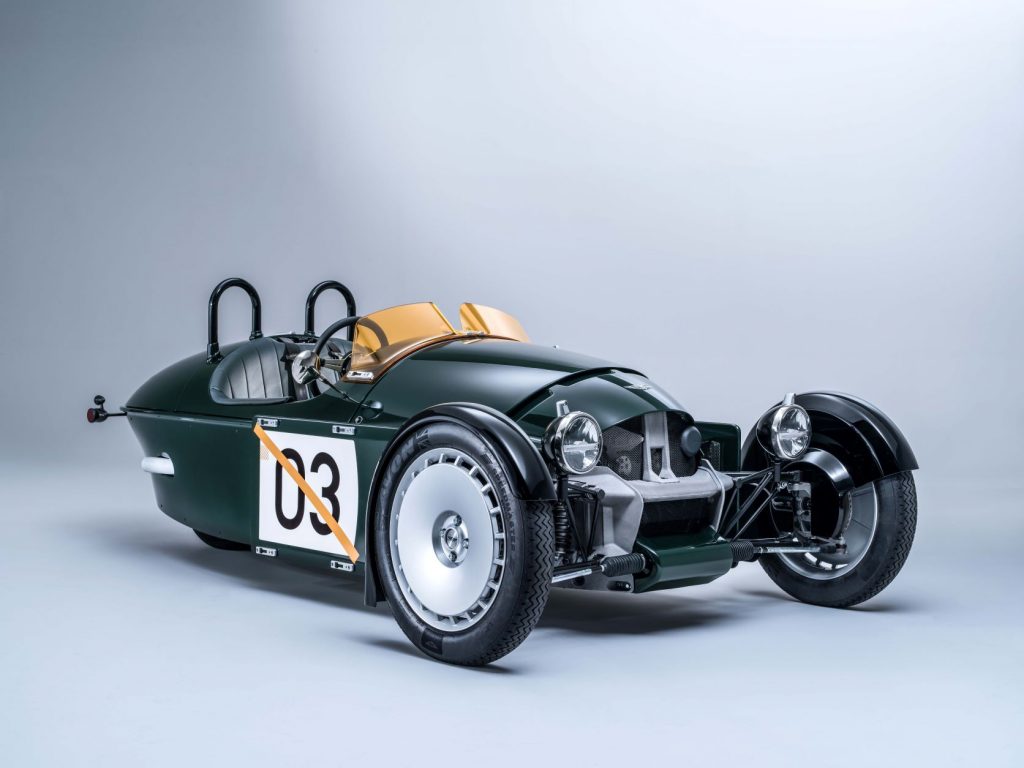
Face
Super 3’s face portrays two familiar headlights and a horseshoe front grille, both recognisable elements of Morgan design. Mounted on the headlight pods are two small, machined aluminium turrets. These turrets house the indicators and position lights, satisfying wide field-of-vision requirements and resulting in the headlights themselves sitting lower.
The engine resides beneath the nose cone, which is positioned deliberately to deliver both optimal weight distribution and desirable proportion. This visual mass sits directly behind the centre line of the front wheels. Beneath the cowl, the engine is visible through a mesh with its moving mechanical components clear to see.
Bracing the engine are structural aluminium castings finished in silver or black. These castings support the engine and corner packages while also ducting air into the cooling packs. The mechanical requirements of these castings have become a crucial design element.
All of the elements of Super 3’s wishbones, pull-rod suspension and headlight structure have been shaped to assist airflow to the radiators behind them, and the mechanical complexity is reminiscent of that of early-century three-wheeled Morgans. The headlight stalks themselves are structural, acting as an additional brace between the upper and lower wishbone pick-up points, while continuing to reflect the vehicle’s trihedral theme.
As well as providing an aerodynamic advantage, the pull-rod suspension brings dynamic benefits by reducing unsprung weight. In parallel with the shape of the front casting, it facilitates a free flow of air towards the side-mounted radiator packs.
The engine mount strategy is unique to Super 3. Specifically, the Hartland Strut – named after the Morgan engineer who designed it – is the foremost mount and integral to the face of the car, while managing the torque reaction of the engine.
The front wheel design is by Morgan. The wheels’ positive offset allows for the longest possible suspension wishbones, with the brakes mounted far out. This maximises ride quality, handling and stability. The inside face of the wheel arches is closed-off, which works aerodynamically both to reduce wind noise and to help the flow of cooling air to the radiators behind them. To keep Super 3 looking proportionally correct, an all-new tyre has been developed with Avon.
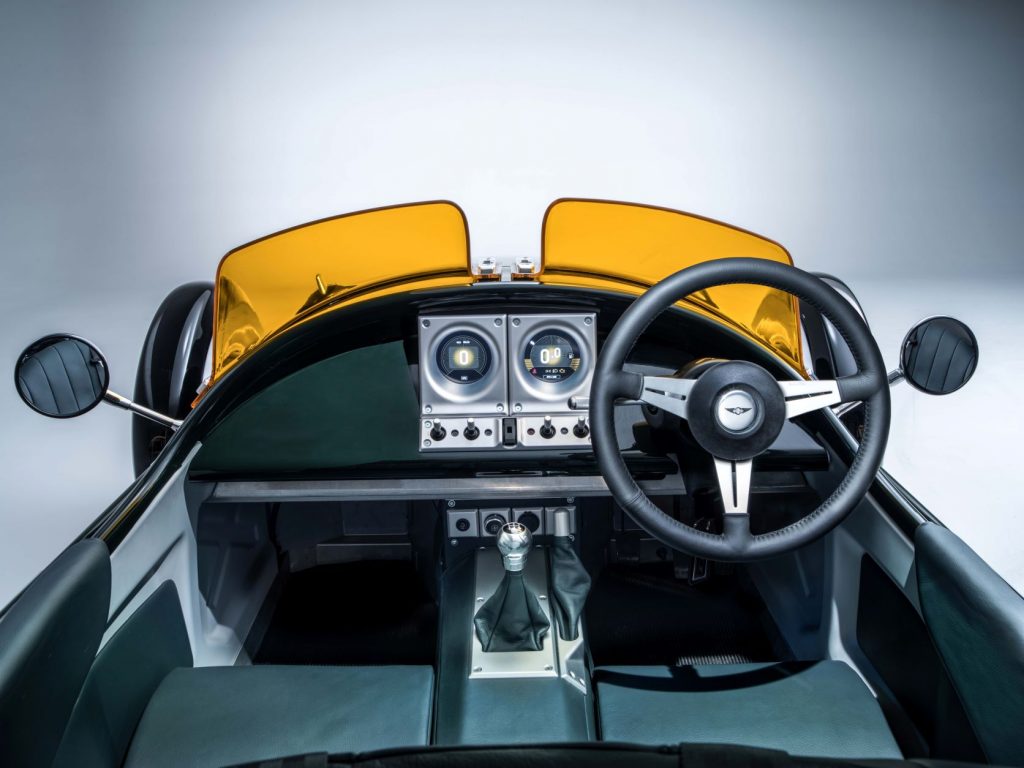
Sideblades (diffuser plates)
One challenge faced during the creation of Super 3 was the desire to maintain a small footprint while also improving on the turning circle of the outgoing model. Sculpted castings carefully flank the engine, with rectangular radiators sitting outboard of these castings, and this limited the space available for the front wheels.
To overcome this challenge, the radiators have been encapsulated behind extremely thin and flat panels. On a jet aircraft, these panels would be referred to as ‘diffuser plates’; on Super 3, these ‘diffuser plates’ are referred to as the ‘sideblades’. The sideblades efficiently manage inbound and exhaustive airflow through the radiators.
Coincidently, this aesthetic reflects a long-standing Morgan design trait of a central body flanked by separate wing forms.
The sideblades also allow numerous luggage mounting options thanks to some uniquely designed universal fixings, also referred to as ‘accessory rails’. Owners can choose from a range of panniers and exo racks that are neatly fixed and secured to the sideblades. The feedback and experience of existing 3 Wheeler owners has been instrumental in determining Super 3’s adventure and touring credentials. During a decade of Morgan 3 Wheeler production, owners have taken their vehicles on road trips and adventures around the world. These adventures, combined with adventure motorcycle touring and overland vehicle design, provided inspiration to Super 3’s designers throughout the project.
Sideblades can be painted to match the main body colour or finished in a contrasting colour, and they provide a canvas for the application of decals and livery packs.
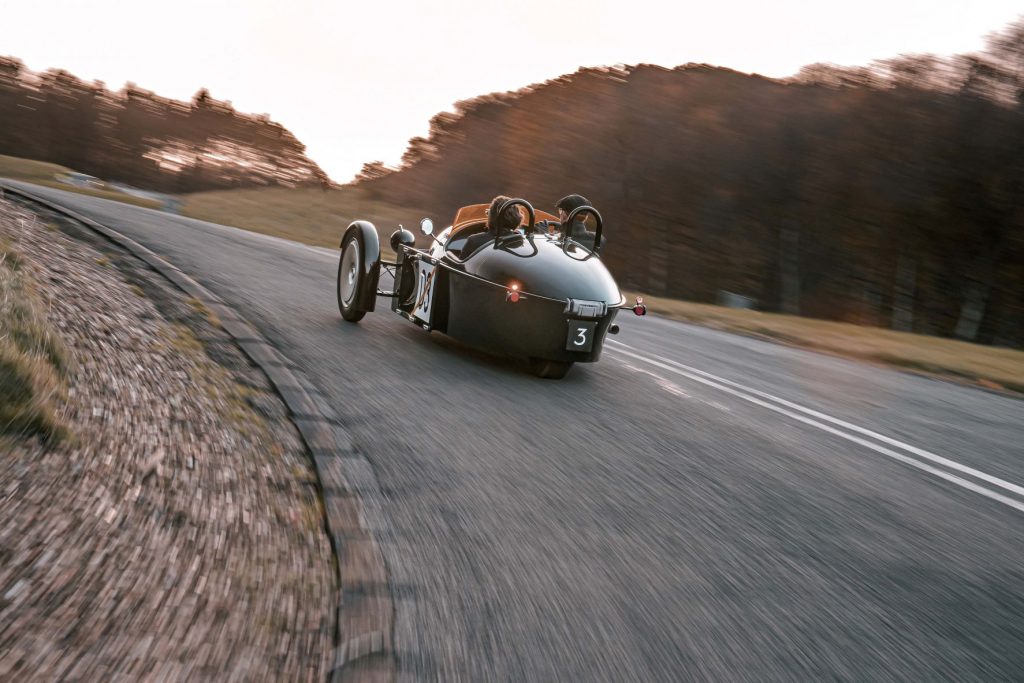
Tail
The tail has been designed for elegant, streamlined simplicity. An exposed rib forms a beltline around the vertical midpoint of the vehicle. This feature is a nod to traditional seam joining techniques deployed on mid-century aircraft fuselages, and it is often apparent in ‘belly tank’ racers and early jets. Beneath it lies a unique cut-off tailpipe design.
A casting at the rear apex of Super 3 mirrors the texture and functional prowess of the front castings. Primarily, the rear casting clamps the two sides of the monocoque structure together. However, it also houses the fog and reverse lights, provides a base for the number plate mount and obscures the all-important pressure relief venting for the rear wheel well. Furthermore, the rear casting integrates a hinge for the rear boot lid and optional luggage rack, and it allows this accessory to be lifted independently or in unison with the boot. Underneath the rear clamshell boot is an enclosure sculpted to provide maximum luggage capacity.
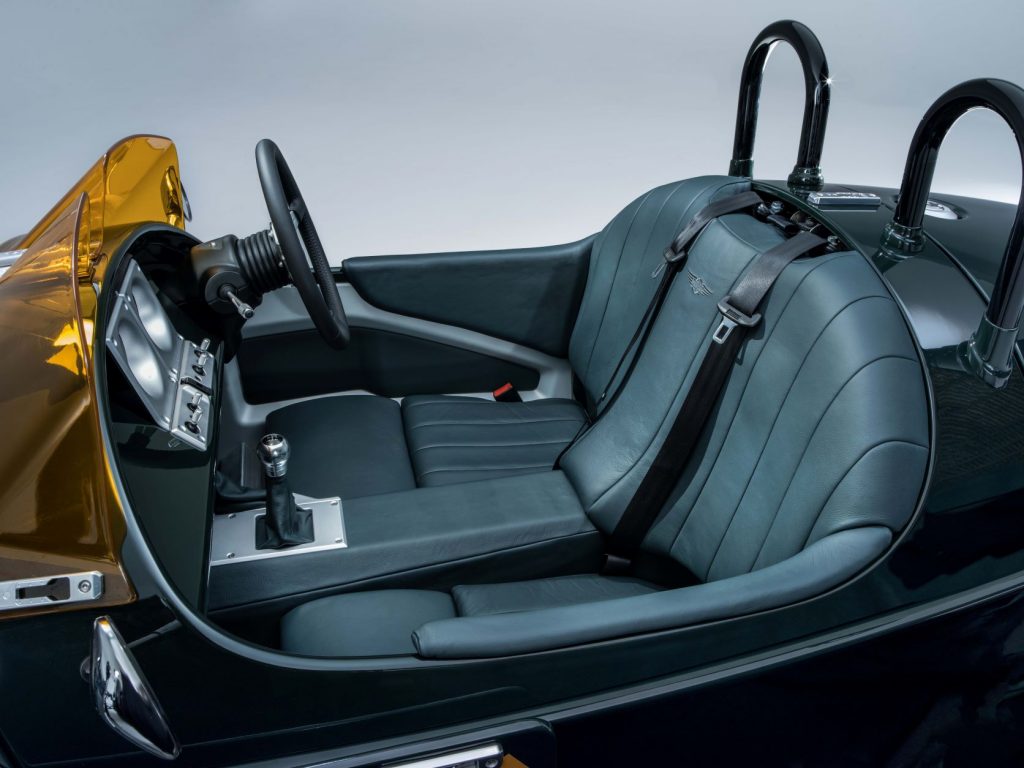
Interior
The interior of Super 3 has – necessarily, given its adventure credentials – been designed for resilience. Any part of the interior is completely dust-tight and protected against water splashing from any direction, even down to the integrated USB sockets.
The minimalist dashboard features Morgan’s traditional centre-mounted dials, but for the first time in a Morgan they are fully digital. Their surrounds – available in both anodised black or silver finishes – are formed from metal, just like any touchpoint in the cabin. The engine start/stop button, inspired by the ‘missile release’ button on military aircraft, is carried over from the outgoing model.
A choice of seat materials includes vinyl, water-resistant leather, saddle leather with enhanced durability and a technical fabric that combines a high level of water resistance, UV resistance and ease of maintenance and which offers an appealing alternative to leather.
Available for the first time is a footwell heater, making Super 3 even more suitable for adventure, while comfort is further enhanced by a reach- and rake-adjustable steering wheel and a quick-release adjustable pedal box.
A universal fixing – the same as the ones mounted to the vehicle sideblades – is mounted under the dashboard and allows for a cup holder or Quad Lock phone mount to be fitted. Bungee cords can be fitted to the chassis impressions in the outer cockpit to provide a quick storage solution for coats, maps and small bags, while a discreet lockable underseat compartment allows more valuable items to be stored.
Platform
Underpinning the Morgan Super 3 is a bonded aluminium Superformed monocoque platform. Morgan’s expertise with bonded aluminium platforms dates back more than two decades, to the start of Aero 8 production, and was furthered with the CX-Generation platform used in the 2020 Plus Four and 2019 Plus Six. Super 3’s platform evolves that technology further still.
For the first time in Morgan history, the platform is a true monocoque, with stressed exterior ‘A-surfaces’ (as opposed to a unibody design found on most modern production cars, with bolt-on non-structural panels). Not only does this make for a lighter and more rigid chassis but also provides packaging benefits and gives more interior occupant space with no intrusion. Its rigidity not only benefits the car’s dynamic capability but also enhances safety, with Super 3 meeting the same exacting M1 and Reg. 12 frontal impact standards as Morgan’s Plus Four and Plus Six four-wheeled cars.
Super 3 continues Morgan’s long-standing use of Superform technology. The heating of aluminium to a superplastic state before vacuum forming it allows for intricate exterior shapes to be created with a lower material stress than pressing. While Superformed exterior panels are a proven technology in automotive production, this is the first time the process has been used to produce a structural vehicle platform.
Further displaying Morgan’s use of innovative construction techniques is the exposed structural front casting. As well as providing the rigidity of the car and mounting points for the suspension while performing a vital safety function, it also carries the attractive finish required of an A-surface. As a display of the car’s mechanical honesty, it provides a link to motorcycles, which use exposed castings in their frames.
Drivetrain
In 1933, Morgan introduced the F-Type three-wheeler, which made the switch from V-twin power to a conventional Ford engine, housed under a bonnet. Almost a century later, Ford has again been chosen to supply the engine, specifically its innovative 1.5-litre naturally aspirated three-cylinder petrol engine. Powerful, efficient and characterful, it provides a combination of attributes which make it perfectly suited to its application in the Morgan Super 3. Extensive development has gone into tuning the engine’s acoustic content and enhancing its natural and distinctive three-cylinder character. It is exceptionally compact and has allowed Super 3’s design to remain true to form without compromising passenger space.
The engine is coupled to five-speed Mazda gearbox, as found in MX-5 and used in the outgoing Morgan 3 Wheeler. Unlike the previous model, however, no compensator is required in the driveline, therefore minimising complexity and weight. The bevel box has been re-engineered using a custom tooth profile, and it drives through a carbon fibre-reinforced drive belt.
The powertrain meets motorcycle Euro 5a, which is in line with cars, and will meet Euro 5b which includes OBD requirements.
Driving dynamics
Core to any Morgan product is driving enjoyment. Super 3 is no exception. It is fundamentally stable – achieved through a dedication to keeping the vehicle’s mass within its contact triangle – and feels planted but with an assertive turn-in feel. Pull-rod suspension is key to this, bringing mass inboard and reducing unsprung mass while aiding airflow to the radiators.
Morgan has worked in partnership with Avon to develop its own 20-inch diameter tyre for Super 3. Reviving the iconic Speedmaster name, the tyre is based on the look of a heritage motorcycle tyre with ‘ballooned’ sidewalls but has been engineered specifically for Morgan and is closer to a car tyre in its design.
The rear tyre on a three-wheeler plays a crucial role in the handling and dynamic capabilities. The company has undergone a rigorous testing program to determine the exact tyre choice for the rear of Super 3. After significant real-world testing and simulation, an Avon all-season tyre was selected to provide optimum slip angle. The rear tyre on a three-wheeler is often subjected to the dirtiest, wettest part of the road, and as the driving tyre it must maintain appropriate contact and grip.
Extensive development has also taken place to tune the feel of the controls. For example, the clutch is deliberately well weighted with a short travel, to reflect the short throw of the gearbox. Particular attention has been paid to the pedal spacing, allowing easy heal-and-toe gearchanges and retaining a playful feel.
While mechanical connection was crucial, refinement has been enhanced thanks to a combination of the rigidity of the bonded chassis and extensive drivetrain development. A new bevel box with custom tooth profiles (see drivetrain, above) reduces additional noise, and has been carefully tuned to ensure it maintains a straight-cut, race-car feel but without an overbearing mechanical noise.
Durability
The Super 3 marks Morgan’s most comprehensive vehicle development program yet. The company has employed a new level of competence in CAE (computer-aided engineering) and structural durability simulations. Its engineering practices are in line with many OEM whole-vehicle programmes and far exceed motorcycle standards.
In testing, Super 3 has outperformed its targets. Several validation prototype vehicles have been operational at numerous proving grounds, undergoing continual durability programs comprising Belgian pavé, torsional ramps and continuous full-bore acceleration and braking tests.
Further test vehicles have undergone ‘real-world’ mileage accumulation in all conditions, exceeding the parameters of any testing program operated by the company to date and allowing for extensive insight into the life of the vehicle.
Particular focus has been paid to Super 3’s cooling package. Using a temperature-, pressure- and load-controlled environment, simulations have included the running of the car fully laden in some of the harshest and most challenging environments in the world, all of which were achieved with high levels of cooling redundancy.
Customisation
Super 3 is the most configurable Morgan to date with an extensive list of more than 200 options and accessories, each one allowing owners to tailor their Super 3. A key project aim was to design and homologate all accessories and options alongside the development of the main vehicle. This not only ensures that those options work in total harmony with the vehicle but also removes the need to retrofit additional options once the vehicle has been built.
Feedback from owners of previous three-wheeled models has been instrumental in defining some of the key accessory themes. These themes include adventure touring, contemporary design and classic motorsport.
Morgan has developed many of its own options and accessories and worked with several key partners to help curate the options available. These project partners include Malle London, Beeline and Quad Lock.
Ordering
Super 3 is available to order from Morgan dealerships in the UK, Europe, the USA and select ROW markets at launch. Customers in the UK and Europe will receive their vehicles first, with USA deliveries following later in 2022. Japan, Australia and select other ROW markets will follow thereafter. Interested customers are encouraged to contact their nearest Morgan dealership for information on availability in their market.
The price for Super 3 starts at £34,958.33 excluding local market taxes. In the UK, which is Morgan’s biggest market, Super 3 is £41,995 plus on-the-road costs. Pricing is in line with the outgoing model, which finished production in 2021 with a limited run of P101 special editions.
Technical specification
Engine: Ford 1.5-litre, inline three-cylinder
Gearbox: Five-speed manual
Maximum power: 118 bhp (87 kW) at 6500 rpm
Maximum torque: 110 lb ft (150 Nm) at 4500 rpm
Acceleration 0-62 (0-100kph): 7 seconds (pending final certification)
Top speed: 130 mph (209 kph)
Fuel economy (combined): 40 mpg (pending final certification)
CO2 emissions: 130g/km
Dry weight: 635kg
Length: 3581mm
Width: 1850mm
Height: 1132mm
